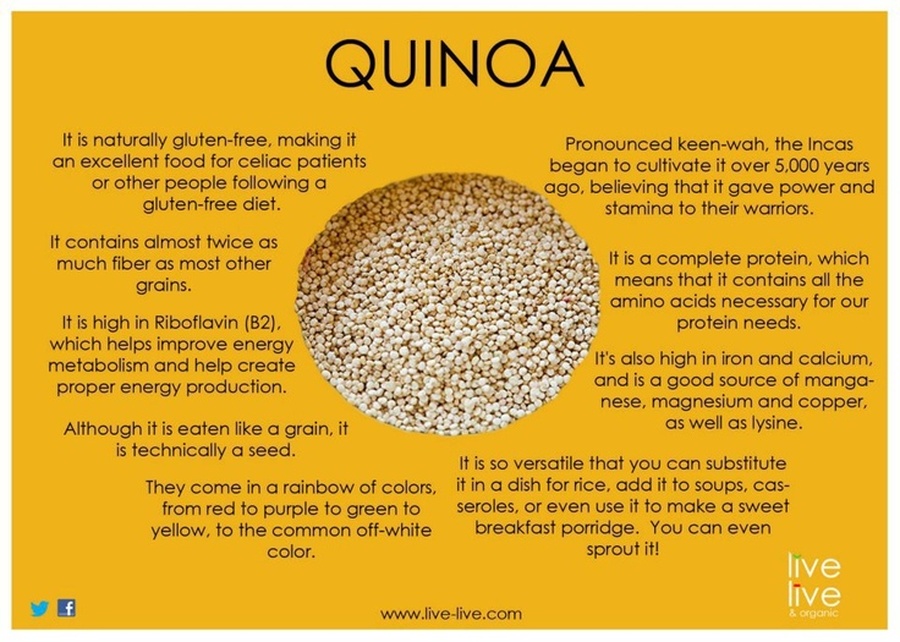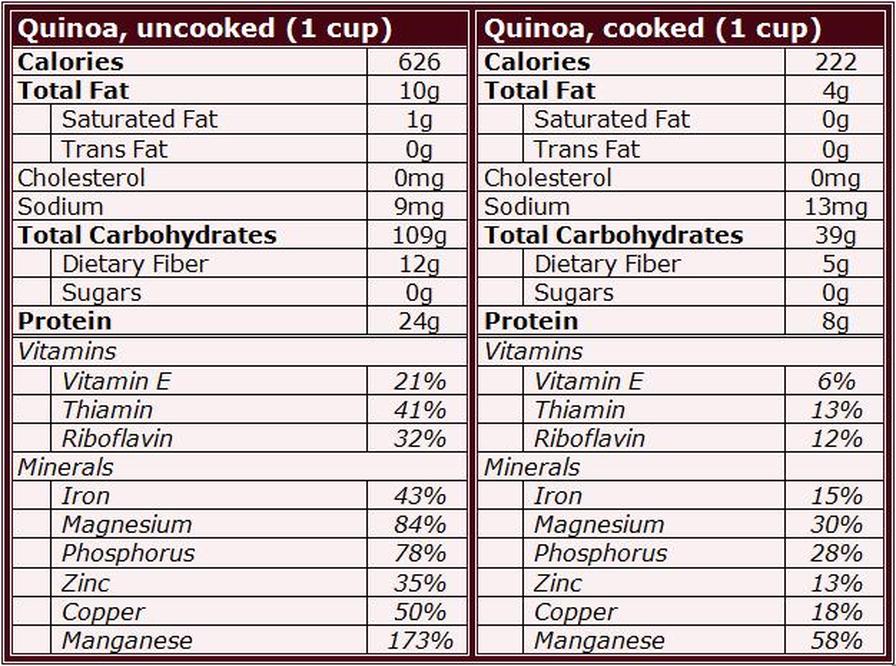
Over 5,000 years ago, high in the Andes mountains, the Incas began to cultivate quinoa (pronounced keen-wah) as one of their staple crops, believing that it gave power and stamina to their warriors. Quinoa was also used in their ceremonial rituals. When Spanish conquistadors arrived in South America in the sixteenth century, they burned and destroyed the quinoa fields as part of the effort to annihilate Inca culture. But quinoa survived by growing wild in the mountains or by being cultivated in secret in small quantities. In the 1980s, two North Americans stumbled upon this ancient, super-nutritious food and began cultivating it near Boulder, Colorado. Since then, quinoa's popularity has exploded worldwide.
Although it is cooked and eaten like a grain, quinoa is technically a seed, and is related to spinach, chard and beets. It grows best in mountainous regions, 10 thousand feet or more above sea level, and thrives in poor soil, thin air and extreme weather. Quinoa stalks are 3 to 6 feet tall, and each plant can produce up to a cup of seeds! The seeds are round, about the same size of millet or sesame seeds, and come in a rainbow of colors, from red to purple to green to yellow, but the quinoa that is most commonly found in stores is an off-white color. Look for quinoa in the bulk section of natural food stores, or in the organic section of conventional supermarkets.
A Complete Protein and so Much More
Quinoa is a complete protein, which means that it contains all the amino acids necessary for our nutritional needs. Complete proteins are rare in the plant world, making quinoa an excellent food for vegetarians and vegans, or for anyone looking for healthy protein source. It's also high in iron and calcium, and is a good source of manganese, magnesium and copper, as well as fiber.
Cooking With Quinoa
Most commercially available quinoa has already been cleaned, but you should still give it a thorough rinsing before cooking to be sure to remove any remaining saponins, a soapy resin that protects the seeds while they are growing, but can impart a bitter taste if not removed. Combine one cup rinsed quinoa to two cups water or broth, bring to a boil, then simmer for 10 to 15 minutes, until the seeds become translucent and the germ of the seed uncoils to form a little "tail." Quinoa has a light, slightly nutty taste and a fluffy texture. It makes a tasty porridge or casserole and can be added to soups and stews.
The Gluten-free Grain of Choice
Quinoa is naturally gluten-free, making it an excellent food for celiac patients or other people following a gluten-free diet. Quinoa flour is great for baking cookies, breads and muffins, and quinoa flakes are a perfect substitute for oatmeal.
The nutrients in 100 g of uncooked quinoa include 13 g of moisture, 368 kcal of energy, 14 g of protein, 6 g of fat, 64 g of carbohydrate and 7 g of dietary fiber. Minerals in quinoa include 47 mg of calcium, 4 mg of iron, 197 mg of magnesium, 457 mg of phosphorus, 563 mg of potassium, 5 mg of sodium, 3 mg of zinc. Vitamins in quinoa include thiamin, riboflavin, niacin, vitamin B6, folate, vitamin B12, vitamin A and vitamin E.
Health Benefits of QuinoaQuinoa is a nutritive food good for health. It provides various health benefits. Some of which include:
Antioxidant properties: Quinoa has antioxidant properties which help in protecting heart, liver, kidney, lungs and pancreas against oxidative stress. When compared with other pseudocereals such as amaranthus, quinoa had higher antioxidant activity. Some of the antioxidants found in quinoa include total phenoilics, polyphenols and anthocyanins. Sprouts of quinoa have also shown significant antioxidant activity.
Supply of good proteins: Quinoa plant has been highly regarded for its protein value, not because it has very high protein instead, it’s a source of essential amino acids like lysine, methionine and tryptophan which cannot be synthesized in the body.
Good for lipid profile and glucose level: Quinoa seeds can be beneficial in regulating blood glucose levels and blood cholesterol levels. A study on high fructose fed rats indicated that consumption of quinoa seeds can help in reducing adverse effects of fructose on glucose level and lipid profile.
High calcium content: The amount of calcium found in quinoa is similar to that of dairy products and it has been pointed out that those who are intolerant of dairy products can eat quinoa. Calcium is very important for bones, brain and nervous system.
Reduced risk of cardiovascular diseases: Quinoa is a pseudo cereal that contains high quality protein and carbohydrates with low glycaemic value along with omega 3 and omega 6 fatty acids and antioxidants are considered good for reducing the risk of cardiovascular diseases in the future. Trials on young and middle aged people confirmed decreased risk of cardiovascular diseases.
Good for digestive system: Quinoa contains insoluble fiber which helps in free bowel movement. This further helps in reducing risk of flatulence, bloating, pain and gas.
Reduces risk of gallstones: The fibre found in quinoa also helps in reducing the risk of gallstones. Consumption of quinoa helps in reducing secretion of bile juice which aid in formation of gallstones.
Good source of magnesium: Magnesium is one of the trace elements found in quinoa. Dietary intake of magnesium provides benefits such as control of asthma, increase of bone health, reduced risk of osteoporosis, keeping heart healthy and regulation of blood sugar level.
Control of appetite: A study found that high intake of wheat, oat, spaghetti, rice, oat spaghetti induced more eating. On the other hand, alternatives or pseudocereals like quinoa, amaranthus when eaten did not induce more eating. This is particularly important for those who want to control their diet and want to lose weight. Taking quinoa will reduce the excess intake of food and thereby promote healthy weight.
Quinoa -Quick Serving Tips
Before cooking quinoa, one has to make sure that the saponin layer on the seeds has to be removed. In most cases, quinoa bought in the US is rinsed off and dried but to be extra careful, you can rinse it off. This saponin can give bitter taste to quinoa if it is not rinsed off properly.
Boiled quinoa: Quinoa after soaking and rinsing can be boiled in water. 1 cup of quinoa takes about 1½ cups of water to boil. Boil it for about 15 minutes. Add a pinch of salt for it to cook. While pressure cooking, only 5 minutes of high flame cooking is required.
Quinoa salad: Quinoa can be added to salad with the choice of your vegetables and seasoning. Quinoa salad tastes good and is also nutritious.

Quinoa contains phytic acid and require soaking, sprouting or fermenting to reduce or eliminate the anti-nutrients.